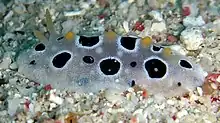| Phyllidia babai | |
|---|---|
 | |
| A live individual of Phyllidia babai, head end towards the left | |
| Scientific classification | |
| Domain: | Eukaryota |
| Kingdom: | Animalia |
| Phylum: | Mollusca |
| Class: | Gastropoda |
| Subclass: | Heterobranchia |
| Order: | Nudibranchia |
| Suborder: | Doridina |
| Superfamily: | Phyllidioidea |
| Family: | Phyllidiidae |
| Genus: | Phyllidia |
| Species: | P. babai |
| Binomial name | |
| Phyllidia babai Brunckhorst, 1993[1] | |
Phyllidia babai is a species of sea slug, a dorid nudibranch, a shell-less marine gastropod mollusk in the family Phyllidiidae.[1][2]
The specific name babai is in honor of Kikutaro Baba,[1] Japanese malacologist.
Distribution
The holotype of this species was collected at Lion Island, Papua New Guinea, 9°32′10″S 147°16′19″E / 9.536°S 147.272°E. It has also been reported from North Sulawesi, Lembeh Strait, southern Queensland, Australia, South Korea and rarely on Okinawa.[3] A number of similar coloured species have been found but are probably not yet named.[4]
Description
This nudibranch has a cream to light yellow coloured dorsum with white tubercles in the center of black rings and the mantle finely edged in yellow. The clavus of each rhinophore has 21 to 24 lamellae, and the rhinophoral pocket is trimmed in white. Its white-coloured, pointed, oral tentacles have lateral grooves, and they also are trimmed in yellow. The ventral surface is a pale cream colour.[3]
Diet
This species has been observed feeding on the yellow sponge Acanthella stipata.[5]
References
- 1 2 3 Brunckhorst, David J. (1993). "The systematics and phylogeny of phyllidiid nudibranchs (Doridoidea)". Records of the Australian Museum. Supplement. 16: 1–107. doi:10.3853/j.0812-7387.16.1993.79.
- ↑ Bieler R, Bouchet P, Gofas S, Marshall B, Rosenberg G, La Perna R, Neubauer TA, Sartori AF, Schneider S, Vos C, ter Poorten JJ, Taylor J, Dijkstra H, Finn J, Bank R, Neubert E, Moretzsohn F, Faber M, Houart R, Picton B, Garcia-Alvarez O, eds. (2022). "Phyllidia babai Brunckhorst, 1993". MolluscaBase. World Register of Marine Species. Retrieved 27 February 2022.
- 1 2 Rudman, W.B. (1999). "Phyllidia babai". The Sea Slug Forum, Australian Museum, Sydney. Retrieved 2010-07-30.
- ↑ Stoffels, Bart E.M.W.; van der Meij, Sancia E.T.; Hoeksema, Bert W.; van Alphen, Joris; van Alen, Theo; Meyers-Muñoz, María Angélica; De Voogd, Nicole J.; Tuti, Yosephine; van der Velde, Gerard (2016). "Phylogenetic relationships within the Phyllidiidae (Opisthobranchia, Nudibranchia)". ZooKeys. 605: 1–35. doi:10.3897/zookeys.605.7136. hdl:2066/162017.
- ↑ Jack Chen (2019). "Phyllidia babai,Baba's Phyllidia". Oceancreature. Retrieved 27 February 2022.
Further reading
- Coleman, N. (2001). 1001 nudibranchs, catalogue of the Indo-Pacific sea slugs. Neville Coleman's Underwater Geographic Pty. pp. 144 p.
- Colin, Patrick Lynn; Charles Arneson (1995). Tropical Pacific Invertebrates, a field guide to the marine invertebrates occurring on tropical Pacific coral reefs, seagrass beds and mangroves. Vol. vii. Beverly Hills: Coral Reef Press. pp. 296 p.
- Debelius, H. (1996). Nudibranchs and sea snails Indo-Pacific field guide. IKAN Underwasserarchiv. p. 321.
- Fahrner, Alexander; Lothar A. Beck (2000). "Identification key to the Indo-Pacific species of the nudibranch family Phyllidiidae Rafinesque 1814, including the description of two new species (Gastropoda: Opisthobranchia)". Archiv für Molluskenkunde. 128 (1–2): 189–211.
- Gosliner, T.M.; D.W. Behrens; G.C. Williams (1996). Coral reef animals of the Indo-Pacific. Vol. vi. Sea Challengers. p. 314.
- Marshall, J.G.; Richard C. Willan (1999). Nudibranchs of Heron Island, Great Barrier Reef. A survey of the Opisthobranchia (sea slugs) of Heron and Wistari Reefs. Leiden: Backhuys Publishers. p. 257.
- Masuda, Hajime (1999). "Nudibranchia pp. 89-136". Guide book to marine life. Tokai University Press. p. 404. (in Japanese)
- Nakano, Rie. Opisthobranchs of Japan Islands. Rutles Inc. p. 199. (in Japanese)
- Ono, Atsushi (1999). Opisthobranchs of Kerama Islands. TBS-Britannica Co. Ltd. p. 122. (in Japanese)
- Ono, Atsushi (2004). Opisthobranchs of Ryukyu Islands. Rutles Inc. p. 206. (in Japanese)
- Suzuki, Keiu (2000). Opisthobranchs of Izu Peninsula. TBS-Britannica Co. Ltd. p. 113. (in Japanese)
- Tonozuka, Takamasa (2003). Opisthobranchs of Bali and Indonesia. Hankyu Communications Co. Ltd. p. 115. (in Japanese)
External links
- Photos of Phyllidia babai on Sealife Collection